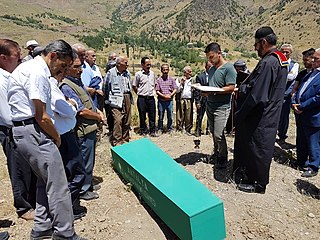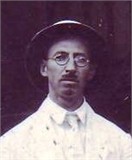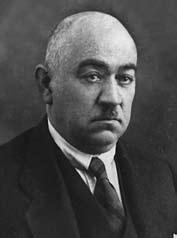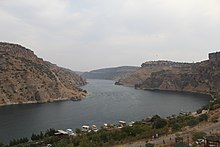
The Armenian genocide was the systematic destruction of the Armenian people and identity in the Ottoman Empire during World War I. Spearheaded by the ruling Committee of Union and Progress (CUP), it was implemented primarily through the mass murder of around one million Armenians during death marches to the Syrian Desert and the forced Islamization of others, primarily women and children.

The Young Turks was a constitutionalist broad opposition movement in the late Ottoman Empire against Sultan Abdul Hamid II's absolutist regime. The most powerful organization of the movement, and the most conflated, was the Committee of Union and Progress (CUP), though its goals, strategies, and membership continuously morphed throughout Abdul Hamid's reign. By the 1890s, the Young Turks were mainly a loose and contentious network of intelligentsia exiled in Western Europe and Egypt that made a living by selling their newspapers to secret subscribers.

Tur Abdin is a hilly region situated in southeast Turkey, including the eastern half of the Mardin Province, and Şırnak Province west of the Tigris, on the border with Syria and famed since Late Antiquity for its Christian monasteries on the border of the Roman Empire and the Sasanian Empire. The area is a low plateau in the Anti-Taurus Mountains stretching from Mardin in the west to the Tigris in the east and delimited by the Mesopotamian plains to the south. The Tur Abdin is populated by more than 80 villages and nearly 70 monastery buildings and was mostly Syriac Orthodox until the early 20th century. The earliest surviving Christian buildings date from the 6th century.

Urmia or Orumiyeh is the largest city in West Azerbaijan Province of Iran. In the Central District of Urmia County, it is capital of the province, the county, and the district.

The Sayfo, also known as the Seyfo or the Assyrian genocide, was the mass slaughter and deportation of Assyrian/Syriac Christians in southeastern Anatolia and Persia's Azerbaijan province by Ottoman forces and some Kurdish tribes during World War I.

Siirt is a city in the Siirt District of Siirt Province in Turkey. It had a population of 160,340 in 2021.

Midyat is a municipality and district of Mardin Province, Turkey. Its area is 1,241 km2, and its population is 120,069 (2022).

Assyrians in Turkey or Turkish Assyrians are an indigenous Semitic-speaking ethnic group and minority of Turkey who are Eastern Aramaic–speaking Christians, with most being members of the Syriac Orthodox Church, Chaldean Catholic Church, Assyrian Pentecostal Church, Assyrian Evangelical Church, or Ancient Church of the East.
İzbırak is a neighbourhood of the municipality and district of Midyat, Mardin Province in southeastern Turkey. It is located in the historical region of Tur Abdin.

Mehmed Reshid was an Ottoman physician, official of the Committee of Union and Progress, and governor of the Diyarbekir Vilayet (province) of the Ottoman Empire during World War I. He is known for organizing the 1915 genocide of the Armenian and Assyrian communities of Diyarbekir, in which between 144,000 and 157,000 Armenians, Assyrians, and other Christians were killed. During the Allied occupation of Istanbul, Reshid was arrested and his roles in the massacres were exposed. He later escaped from prison, but committed suicide after being cornered by local authorities.

Ignatius Shoukrallah Maloyan, ICPB was the Armenian Catholic Archbishop of Mardin between 1911–15, when he was killed in the Armenian Genocide. He was beatified by Pope John Paul II as a martyr in 2001.
Massacres of Diyarbakır were massacres that took place in the Diyarbekir Vilayet of the Ottoman Empire between the years of 1894 and 1896 by ethnic Kurds and Turks. The events were part of the Hamidian massacres and targeted the vilayet's Christian population – mostly Armenians and Orthodox Syrians.

Floyd Olin Smith was an American physician who served in the Ottoman Empire (1913–1917) and the Philippines (1918–1927) under Near East Relief and the Red Cross.

The 1914 Ottoman census was collected and published as the Memalik-i Osmaniyyenin 1330 Senesi Nütus Istatistiki. These statistics were prepared by using the figures from the 1905–06 census of the Ottoman Empire and reflecting births and deaths registered in six years from last. The register states that birth and mortality rate used on "nomads" such as the nomadic Nestorians.

Aziz Feyzi Pirinççizâde was a Turkish politician of Kurdish origin and a leading member of the influential Ottoman Kurdish Pirinççizâde family from Diyarbekir. He took a leading role in the Armenian genocide in the Diyarbekir vilayet during World War I, and he was later accused of taking part in the Sheikh Said rebellion, although he wasn't sentenced for either. Later he served as a Member of the Grand National Assembly of Turkey and a Minister of Public Works in the Turkish Government. He was also awarded the Turkish Medal of Independence.

The Defence of Iwardo was a military engagement between Ottoman authorities and Assyrian defenders led by Gallo Shabo in 1915, during the Assyrian genocide. The pockets of resistance during the Assyrian genocide was named "Midyat Rebellion" after Midyat, the largest Assyrian town in Tur Abdin by the Ottoman authorities.

The village of Azakh was one of the few remaining pockets of resistance during the Sayfo that the Ottoman authorities called the "Midyat Rebellion" named after Midyat, the largest Assyrian town in Tur Abdin.
David Gaunt is a historian and professor at Södertörn University's Centre for Baltic and East European Studies and Member of Academia Europaea. Gaunt's book about the Assyrian genocide, Massacres, Resistance, Protectors, was described as "the most important book that has been published in recent years".
Kocapınar is a village in the Cizre District of Şırnak Province in Turkey. The village is populated by Kurds of the Amara and Meman tribes and had a population of 806 in 2021.
Bozburun is a village in the İdil District of Şırnak Province in Turkey. The village is populated by Kurds of the Domanan tribe and had a population of 129 in 2021. It is located in the historic region of Tur Abdin.

















